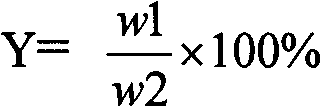Method for producing biodiesel by utilizing kitchen garbage
A technology of food waste and biodiesel, which is applied in the field of resource utilization of food waste, can solve the problems of underutilization of organic matter, underutilization, losses, etc. volume effect
- Summary
- Abstract
- Description
- Claims
- Application Information
AI Technical Summary
Problems solved by technology
Method used
Image
Examples
Embodiment 1
[0052] Food waste (from a canteen of a university in Nanjing), using magnetic separation and manual selection methods to remove various solid impurities, adding water at a volume ratio of 1:4 between food waste and water, crushing and beating with a beater, and making the beated The pH value of the kitchen waste was adjusted to 5.5 (adjusted with dilute HCl), and it was sterilized at 121°C for 15 minutes before use.
[0053] The sterilized culture medium is inoculated with 10% (v / v), and the number of inoculated viable bacteria reaches 10 8 The cfu / mL yeast cell suspension is subjected to liquid fermentation, and the yeast cell suspension is composed of Rhodosporidium yeast and Trichosporidium dermatoides in a ratio of 1:1 of living cells. During the fermentation process, the temperature is controlled at 28°C, and the fermentation time is 72 hours. In the period from 0 to 48 hours, the aeration ratio of the fermenter is 0.4, and the rotation speed of the stirring paddle is 160...
Embodiment 2
[0056] Food waste (from a canteen of a university in Nanjing), using magnetic separation and manual selection methods to remove various solid impurities, adding water at a volume ratio of 1:6 between food waste and water, crushing and beating with a beater, and crushing the beated The pH value of the kitchen waste was adjusted to 6.0 (adjusted with dilute HCl), and it was sterilized at 115°C for 30 minutes before use.
[0057] The sterilized culture medium is inoculated with 10% (v / v), and the number of inoculated viable bacteria reaches 10 9 The cfu / mL yeast cell suspension is subjected to liquid fermentation, and the yeast cell suspension is composed of Rhodosporidium yeast and Trichosporidium dermatoides in a ratio of 1:1 of living cells. During the fermentation process, the temperature was controlled at 28°C, and the fermentation time was 72 hours. In the period from 0 to 48 hours, the aeration ratio of the fermenter was 0.5, and the rotation speed of the stirring paddle w...
PUM
| Property | Measurement | Unit |
|---|---|---|
| acid value | aaaaa | aaaaa |
Abstract
Description
Claims
Application Information
 Login to View More
Login to View More - R&D
- Intellectual Property
- Life Sciences
- Materials
- Tech Scout
- Unparalleled Data Quality
- Higher Quality Content
- 60% Fewer Hallucinations
Browse by: Latest US Patents, China's latest patents, Technical Efficacy Thesaurus, Application Domain, Technology Topic, Popular Technical Reports.
© 2025 PatSnap. All rights reserved.Legal|Privacy policy|Modern Slavery Act Transparency Statement|Sitemap|About US| Contact US: help@patsnap.com


